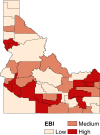Assessment of Pediatric Cancer and Its Relationship to Environmental Contaminants: An Ecological Study in Idaho
- PMID: 35310467
- PMCID: PMC8917512
- DOI: 10.1029/2021GH000548
Assessment of Pediatric Cancer and Its Relationship to Environmental Contaminants: An Ecological Study in Idaho
Abstract
The primary aim of this study was to determine the degree to which a multivariable principal component model based on several potentially carcinogenic metals and pesticides could explain the county-level pediatric cancer rates across Idaho. We contend that human exposure to environmental contaminants is one of the reasons for increased pediatric cancer incidence in the United States. Although several studies have been conducted to determine the relationship between environmental contaminants and carcinogenesis among children, research gaps exist in developing a meaningful association between them. For this study, pediatric cancer data was provided by the Cancer Data Registry of Idaho, concentrations of metals and metalloids in groundwater were collected from the Idaho Department of Water Resources, and pesticide use data were collected from the United States Geological Survey. Most environmental variables were significantly intercorrelated at an adjusted P-value <0.01 (97 out of 153 comparisons). Hence, a principal component analysis was employed to summarize those variables to a smaller number of components. An environmental burden index (EBI) was constructed using these principal components, which categorized the environmental burden profiles of counties into low, medium, and high. EBI was significantly associated with pediatric cancer incidence (P-value <0.05). The rate ratio of high EBI profile to low EBI profile for pediatric cancer incidence was estimated as 1.196, with lower and upper confidence intervals of 1.061 and 1.348, respectively. A model was also developed in the study using EBI to estimate the county-level pediatric cancer incidence in Idaho (Nash-Sutcliffe Efficiency = 0.97).
Keywords: environmental burden index; multivariable statistical analysis; pediatric cancer; pesticides; principal component analysis.
© 2022 The Authors. GeoHealth published by Wiley Periodicals LLC on behalf of American Geophysical Union.
Conflict of interest statement
The authors declare no conflicts of interest relevant to this study.
Figures






Similar articles
-
Investigation of Relationships Between the Geospatial Distribution of Cancer Incidence and Estimated Pesticide Use in the U.S. West.Geohealth. 2022 May 1;6(5):e2021GH000544. doi: 10.1029/2021GH000544. eCollection 2022 May. Geohealth. 2022. PMID: 35599961 Free PMC article.
-
Arsenic levels in ground water and cancer incidence in Idaho: an ecologic study.Int Arch Occup Environ Health. 2009 Jul;82(7):843-9. doi: 10.1007/s00420-008-0362-9. Epub 2008 Oct 22. Int Arch Occup Environ Health. 2009. PMID: 18941772
-
Sources, pathways, and relative risks of contaminants in surface water and groundwater: a perspective prepared for the Walkerton inquiry.J Toxicol Environ Health A. 2002 Jan 11;65(1):1-142. doi: 10.1080/152873902753338572. J Toxicol Environ Health A. 2002. PMID: 11809004 Review.
-
Integrated application of multiple indicators and geographic information system-based approaches for comprehensive assessment of environmental impacts of toxic metals-contaminated agricultural soils and vegetables.Sci Total Environ. 2024 May 20;926:171747. doi: 10.1016/j.scitotenv.2024.171747. Epub 2024 Mar 24. Sci Total Environ. 2024. PMID: 38531460
-
Setting water quality criteria in China: approaches for developing species sensitivity distributions for metals and metalloids.Rev Environ Contam Toxicol. 2014;230:35-57. doi: 10.1007/978-3-319-04411-8_2. Rev Environ Contam Toxicol. 2014. PMID: 24609517 Review.
Cited by
-
Biodegradation of pesticide in agricultural soil employing entomopathogenic fungi: Current state of the art and future perspectives.Heliyon. 2023 Dec 10;10(1):e23406. doi: 10.1016/j.heliyon.2023.e23406. eCollection 2024 Jan 15. Heliyon. 2023. PMID: 38187317 Free PMC article. Review.
-
Hair Levels of Lead, Cadmium, Selenium, and Their Associations with Neurotoxicity and Hematological Biomarkers in Children from the Mojana Region, Colombia.Molecules. 2025 Aug 1;30(15):3227. doi: 10.3390/molecules30153227. Molecules. 2025. PMID: 40807403 Free PMC article.
-
Investigation of Relationships Between the Geospatial Distribution of Cancer Incidence and Estimated Pesticide Use in the U.S. West.Geohealth. 2022 May 1;6(5):e2021GH000544. doi: 10.1029/2021GH000544. eCollection 2022 May. Geohealth. 2022. PMID: 35599961 Free PMC article.
-
Turkish validity and reliability of children's environmental health knowledge and skills questionnaires for nursing students.BMC Nurs. 2025 Feb 27;24(1):226. doi: 10.1186/s12912-025-02846-y. BMC Nurs. 2025. PMID: 40016757 Free PMC article.
-
Cancer InFocus: Tools for Cancer Center Catchment Area Geographic Data Collection and Visualization.Cancer Epidemiol Biomarkers Prev. 2023 May 24;32(7):OF1-OF5. doi: 10.1158/1055-9965.EPI-22-1319. Online ahead of print. Cancer Epidemiol Biomarkers Prev. 2023. PMID: 37222667 Free PMC article.
References
-
- Abdelrehim, M. G. , Mahfouz, E. M. , Ewis, A. A. , Seedhom, A. E. , Afifi, H. M. , & Shebl, F. M. (2018). Dietary factors associated with pancreatic cancer risk in Minia, Egypt: Principal component analysis. Asian Pacific Journal of Cancer Prevention: Asian Pacific Journal of Cancer Prevention, 19(2), 449. - PMC - PubMed
-
- Abdi, H. , & Williams, L. J. (2010). Principal component analysis. Wiley interdisciplinary reviews: Computational Statistics, 2(4), 433–459. 10.1002/wics.101 - DOI
-
- Adiwijaya, W. U. , Lisnawati, E. , Aditsania, A. , & Kusumo, D. S. (2018). Dimensionality reduction using principal component analysis for cancer detection based on microarray data classification. Journal of Computer Science, 14(11), 1521–1530. 10.3844/jcssp.2018.1521.1530 - DOI
Grants and funding
LinkOut - more resources
Full Text Sources
